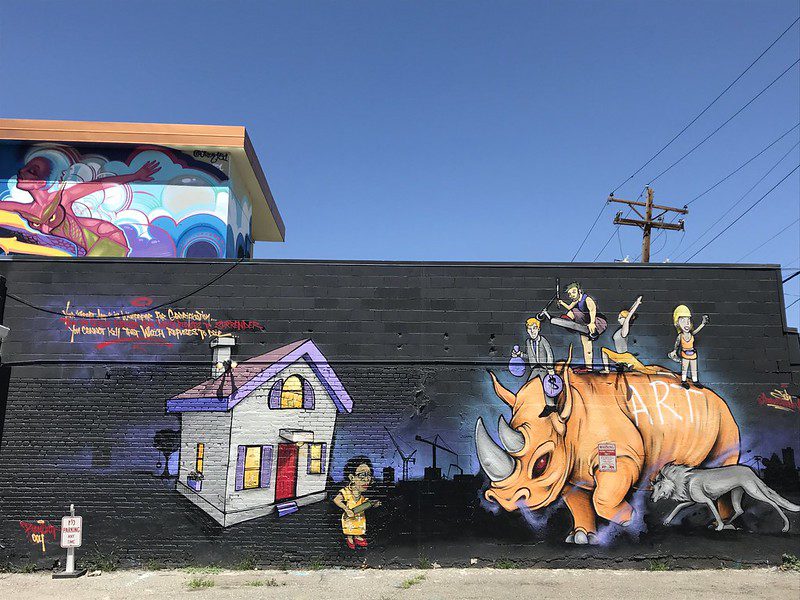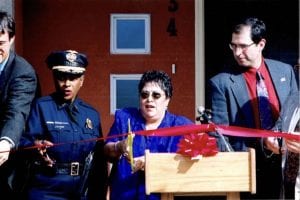
“Your ‘Street Art’ is Wallpaper for Gentrification”—A mural by JOLT (aka Guerrilla Garden) in the River North Art District in Denver, Colorado. Recent studies have named Denver the second most intensely gentrifying city in the U.S. as well as the top city for Hispanic displacement linked to gentrification. Photo by flickr user Adam Gerard, CC BY-NC-SA 2.0
In the late 1980s, residents of the Upper Albany section of Hartford, Connecticut, were struggling. The predominantly Black neighborhood along Albany Avenue, a major thoroughfare and commercial corridor, was plagued with crime and drug activity. The area’s unemployment rate was 12 percent, and more than 29 percent of its nearly 10,000 residents lived in poverty.
Local activists who were trying to improve conditions there got a major boost in 1990. The Ford Foundation announced that it had selected Upper Albany and three other impoverished neighborhoods in Detroit, Memphis, and Milwaukee for its Neighborhood and Family Initiative (NFI), a decade-long investment of about $3 million in each city. In Hartford, the newly formed Upper Albany Neighborhood Collaborative (UANC) set to work organizing residents and making plans to address the area’s needs.
With the funding from Ford and the additional resources it attracted, the collaborative launched dozens of programs over the next several years. Together with partner organizations, the group organized block clubs, set up regular meetings with police and elected officials, installed lighting on private properties to discourage crime, ran youth summer programs, built an arts center, repaired homes, and helped residents find jobs.
“People truly benefited a lot, in the form of coming through our block clubs and our youth council, and going on to college and so on,” says Ron Simpson, a Hartford resident who led UANC from 2001-2002 and remained involved during the decade-long investment. “The whole thing was a springboard for young people such as myself.” UANC remains active to this day, running get-out-the-vote and tax-preparation programs, offering computer classes, and distributing school backpacks, Thanksgiving turkeys, and Christmas gifts.
The partnership between the UANC and Ford was occasionally rocky. In a pair of lengthy articles about foundation-funded community-building initiatives that Shelterforce published in 1997 and 1998, local leaders in Hartford and the other cities that were selected for the NFI program said the Ford Foundation’s goals of comprehensive community change were too ambitious given the amount of funding provided. They felt overwhelmed and controlled by the foundation’s consultants, who often did not provide the right type of technical assistance at the right time.
Simpson also notes that many of those helped by the collaborative ended up moving elsewhere, and he says homeownership has declined in Upper Albany in recent years while renting has increased. The neighborhood still has “high rates of poverty, violent crime, and low levels of formal education,” along with “visible blight,” according to Upper Albany Main Street Inc., an economic development organization. More than 30 percent of families still live in poverty. Meanwhile, UANC has been run entirely by volunteers since the early 2000s, when the Ford Foundation money ran out.
The mixed outcome in Hartford was typical of the NFI neighborhoods. While the initiative helped develop strong community leaders and relationships in the four cities, and increased “hope and commitment among some residents,” its “broader goals of community level change . . . were not realized over the course of the decade,” according to a report from Chapin Hall Center for Children at the University of Chicago.
No Long-Term Impact
NFI was one of several Comprehensive Community Initiatives (CCIs), or place-based initiatives, launched by charitable organizations in the 1990s and early 2000s. The foundations included Annie E. Casey, The California Endowment, Edna McConnell Clark, Enterprise, Hewlett, MacArthur, Pew Charitable Trusts, Robert Wood Johnson, Rockefeller, Surdna, and several others. The federal government pursued similar aims during that period through programs such as HOPE VI and Empowerment Zones.
While their methods and specific goals varied, the CCIs all sought to bring focused resources and the lessons of past revitalization initiatives to poor, urban neighborhoods in order to effect broad change at the individual, neighborhood, and systems levels. They aimed to help local groups organize their communities, develop leaders, improve the physical infrastructure, boost their economies, enhance access to human services, and strengthen social bonds.
‘Many that call themselves place-based initiatives are, in my view, far too small to have made any material difference in the neighborhood.’
But like the Ford Foundation’s initiative, the efforts largely failed to make a lasting measurable impact. While some achieved short-term goals, such as producing housing or creating new organizational networks, “most of the interventions have not produced the degree of community transformation envisioned by their designers,” wrote Anne Kubisch, former director of the Aspen Institute Roundtable on Community Change. Kubisch’s analysis appears in “Voices from the Field III,” a book about CCIs the institute published in 2010.
“Few (if any) have been able to demonstrate population-level changes in child and family well-being or rates of poverty. Where significant community-wide change occurred, it was the result of changes in the population of the neighborhood due to mobility caused by regional economic dynamics or major physical revitalization that often meant displacement of significant numbers of the original residents (e.g., HOPE VI),” she wrote. HOPE VI replaced public housing with mixed-income developments, which usually led to less housing for poor residents.
Kubisch is now president of The Ford Family Foundation, a grant-making organization in Oregon unrelated to the New York-based Ford Foundation that funded the NFI. In a recent interview with Shelterforce, she said she believes the theory underlying CCIs is still valid. Addressing complex problems in vulnerable communities requires integration and layering of interventions, along with a community-building approach to engage residents and make programs sustainable. It’s just that “the implementation was really hard,” she says, and funders did not stick with neighborhoods long enough to make deep changes.
“The problem was, they were structured in the form of an ‘initiative’ because of the way foundations thought about things. If you have a theory of philanthropy that says, ‘We want to pilot something, show how it works, and then move on,’ you automatically by definition have this time-limited sense. You announce, ‘We’re going to provide some fixed amount of money on an annual basis, and we’re going to do it for 10 years and we expect that we’re going to change the world in these 10 years.’ That just didn’t make any sense. It just doesn’t match the reality,” she says.
The amount of financial investment by most CCIs has also been inadequate, says Brett Theodos, director of the Community Economic Development Hub at the Urban Institute, whose research focuses on philanthropic and government neighborhood-change efforts.
“Many that call themselves place-based initiatives are, in my view, far too small to have made any material difference in the neighborhood. Putting $10 million into a 24-square-mile area and calling it a place-based initiative—it’s just not going to happen,” he says. “The national foundations, all of them have tried this—MacArthur, Ford, Rockefeller—but their attentions wander and so they haven’t seen any of them through. These take, in my view, more than 20 years to see through, possibly more than 30. A five-year effort with $10 million is not going to get it done.”
A Costly Distraction
The national funders in particular have struggled to make comprehensive change because they lack a strong local presence and long-term commitment to a particular place, Kubisch and Theodos say. That lack of local connection contributed to problems with another prominent CCI, the Baltimore-based Annie E. Casey Foundation’s Rebuilding Communities Initiative (RCI).
Launched in 1994, RCI spent a total of $15 million over seven years in neighborhoods in Boston, Denver, Detroit, Philadelphia, and Washington, D.C. In West Denver, the lead organization, NEWSED CDC, created a community council, a mental health counseling program, and a youth program, and it gave grants to an arts initiative and other local organizations, says Veronica Barela, NEWSED’s president and CEO from 1977 to 2018. The group’s staffers frequently traveled to meet with RCI leaders in the other four cities.

Veronica Barela, NEWSED CDC’s past president and CEO, cuts a ribbon during the opening event for the organization’s six townhomes in the early 2000s. NEWSED received funding from the Annie E. Casey Foundation in the 90s. Photo courtesy of NEWSED
In retrospect, however, Barela rues RCI’s influence on her organization. NEWSED’s mission had always been to revitalize Santa Fe Drive and the surrounding areas by building shopping centers and affordable housing, but the Casey Foundation and its army of consultants had different priorities, she says.
“They had a hard time understanding our culture. Not only the Latino culture but the culture of Denver, because it’s so different from the East Coast. It took NEWSED away from what we do as community development corporation for several years and it hurt us that way. We were so busy doing Annie Casey [work]; our whole world was wrapped around this initiative,” she says.
“What are CDCs about? We’re not social service agencies, so it was like having a third thumb, dealing with that program,” says Barela, who remains involved with NEWSED and whose daughter succeeded her as CEO.
Her organization did build some housing during that period of time, but without the distraction of RCI it might have done more to obtain housing tax credits and low-cost land that have since become scarce, she says. After the RCI funding ended, NEWSED had to stop sponsoring the PODER community council, which Barela described as a big loss for the neighborhood, and it closed its mental health program. The Casey Foundation’s follow-up initiative, the 10-city Making Connections program, focused on children and families and did not include NEWSED. Any impact from RCI has long since faded away.
“Nobody really remembers the Casey initiative. When you talk about the Rebuilding Communities Initiative, nobody knows what you’re talking about,” Barela says.
RCI did strengthen NEWSED organizationally and in that way it helped the neighborhood, she says. But much of the change in West Denver has been due to other forces, including economic development work by CDCs before and after RCI, and rising real estate prices that have contributed to displacement and demographic change.
While NEWSED’s neighborhood still has two large public housing projects, many of the lower-income families who lived in the area in the 1990s have been forced out by rising housing costs, Barela says. The neighborhood’s Latino population has dropped from 98 percent to under 50 percent and its Black population from 16 percent to 8 percent, she says. Recent studies have named Denver the second most intensely gentrifying city in the U.S. as well as the top city for Hispanic displacement linked to gentrification.
Redevelopment vs. Replacement
Despite the difficulty of effecting change, in the past two decades foundation-funded community-building and anti-poverty efforts have proliferated. They tend to be more narrowly targeted than earlier CCIs, focusing on just one site or a specific programmatic focus, and often operate through a model of individual grant-making to service providers.
The Casey Foundation, for example, has focused on early education and economic interventions for parents. The Ford Foundation, which pioneered CCIs in the 1960s, no longer directly funds place-based initiatives but still gives grants to housing justice groups and a wide variety of other recipients. The Surdna Foundation, whose Comprehensive Community Revitalization Program in the Bronx was a model for promoting community-building through CDCs, now supports organizations working on racial justice and job creation for people of color, among other areas.
In many places local organizations took the lead. The Harlem Children’s Zone, which receives foundation and government funding, runs schools and social services in a tightly defined section of New York. It inspired similar efforts in other cities as well as the federal Promise Neighborhoods program. A 2014 Urban Institute report identified dozens of other neighborhood change efforts around the country, including a CCI organized by the nonprofit Local Initiatives Support Corporation (LISC) in Chicago and The California Endowment’s billion-dollar Building Healthy Communities, which works on health care access, school climate, and justice reform in 14 areas in California. The report noted locally led efforts in Houston, Tulsa, the Baltimore area, Oakland, Los Angeles, Newark, Cincinnati, and other cities, often focusing on a specific priority such as youth development or aid to immigrants.

Students at Charles R. Drew Charter School in East Lake, Atlanta. Photo by the East Lake Foundation
One of the best-funded and well-known comprehensive, place-based initiatives is the East Lake Initiative in Atlanta. In the mid-1990s, wealthy developer Tom Cousins purchased and renovated the elite East Lake Golf Club and then worked with the Atlanta Housing Authority to replace the crime-ridden East Lake Meadows public housing complex with a mixed-income development. The initiative created a high-performing charter school, a public golf course with an apprentice program, a YMCA, early learning centers, health services, and the area’s first grocery store. Funding comes from philanthropy, government, and private market debt and equity financing.
Unlike most other CCIs of the period, the East Lake Initiative has focused on one small area, poured in major resources—more than $600 million so far—and remains in operation. It has drawn plaudits for transforming the housing development and larger neighborhood. Violent crime fell by 90 percent, the employment rate rose from 13 to 70 percent, and the high school graduation rate increased from 30 to 78 percent.
However, the effort has also been criticized as an example of “community replacement” rather than redevelopment. Only one-quarter of the original public housing residents eventually moved back into the new development. Though many left for other reasons, some were screened out as “potential problems” and had to sue to be allowed to return. Compared to other similar communities, by 2018 the Black population in East Lake had fallen 22 percent below the general trend, the white population rose 19 percent, the number of poor households dropped 18 percent, and average home values increased by $153,000, according to a forthcoming analysis by Theodos of the Urban Institute.
“In Atlanta I saw massive change in the neighborhood, but change that looks a whole lot like gentrification, including race change. It’s a really complicated story to assert it was to the benefit of the people living in there in the public housing at the time,” he says.
East Lake inspired a similar project in New Orleans’s Bayou District, which also demolished public housing and built a golf course. When the new mixed-income housing opened in 2010, it excluded unemployed people and those who couldn’t pass credit and background checks, and ended up housing just 125 of the 920 former public housing families.
A fundamental question in CCI work is whether the primary goal is to improve the place or to help the people, even those who leave. Theodos says that two other large CCIs he has studied, the 26-year-old City Heights Initiative in San Diego and the 17-year-old East Baltimore Development Initiative, have so far not significantly changed their neighborhood economies, although the Baltimore project might do so eventually. In San Diego, initiative leaders argue that young people who leave take the investment with them and succeed elsewhere, but that is a different metric and a hard one to measure, Theodos says.
“If you said at the outset, we’re going to invest half a billion dollars into this neighborhood and it’s going to look the same 25 years from now, would you say that’s a success or not? Maybe some people would. But a lot of time these interventions are not entirely clear on their theory of change, or what they’re trying to accomplish for whom,” he says.
The Network Model
Another model for promoting comprehensive neighborhood change is a network that supports or guides local efforts. One such network is Purpose Built Communities (PBC), which Cousins and two other donors, Warren Buffett and Julian Robertson, created in 2009 to nationalize East Lake’s success. Its first project was the Bayou District redevelopment.

Columbia Parc at the Bayou District, New Orleans. Photo courtesy of the Bayou District Foundation
As in Atlanta, the core elements in each of the 28 network sites are mixed-income housing, cradle-to-college education, and wellness services, with racial equity as a central focus. PBC is structured as a free consultancy that helps local leaders create a “community quarterback organization,” like the East Lake Foundation, to set strategy and coordinate the work of schools, government, developers, social service agencies, health providers, and other partners over the long term.
“Local leadership, local skin in the game—the local nature of this is inherently important. We’re talking about places where people live and places where community and business leaders co-invest to try to create better outcomes for people in a particular place,” says Carol Naughton, Purpose Built’s CEO and former executive director of the East Lake Foundation. “That’s something that doesn’t get done in 3 or 5 or even 10 years. It really requires a long-term commitment to a particular community, and evolving with the community over time, based on what the changing needs are.”
PBC does not provide funding, but it does matchmaking with donors and helps network members apply for grants, Naughton says. Last year the Low Income Investment Fund, a nonprofit community development financial institution, began offering below-market interest rate loans for network members, with philanthropic support from JPMorgan Chase.
Asked about displacement of public housing residents at East Lake, Naughton says the criticism of the initiative was a fair one. She then noted that most public housing residents leave within a few years, even when no redevelopment is occurring, and says most of the Purpose Built communities have not had big public housing redevelopments that required families to relocate.
“Most of them are underpopulated neighborhoods where the trick is, how do you convince people to stay and encourage new people to move in? Because the neighborhoods aren’t sustainable based on the current level of population,” she says. “It’s easy for us to think everything’s in a big city, with a big hot market, but lots of the places where we’ve been invited don’t have those dynamics going on at all.”
|
While this piece is free to read, it’s not free to produce. Please consider supporting our small and dedicated team on Patreon. |




I agree with the writer that a key question about Comprehensive Community Initiatives is whether the primary goal is to improve the place or to help the people. I’ve not seen examples where both occur, which is hardly surprising. In neighborhoods which have cycled down, economic forces tend to dwarf volunteer efforts and a relief package, unless it is at the scale of relief only the federal government could (theoretically) provide. We need some folks with money to move in and allow market forces to help–hopefully finding a way to limit gentrification so as not to displace the majority of existing residents–but without that, distressed neighborhoods seem to continue as segregated places where folks with choices just don’t seem to want to be. Every distressed neighborhood has some number of wonderful, caring and motivated people in it, but obviously not enough money to turn it around.
Agreed, which then leads me to ask: isn’t this a classic case of framing the right questions around the understanding that a community is being asked, and expected, to evolve into commercial real estate terms rather than in socioeconomic terms? Two distinct paths, a fork in the road situation. Both are possible but only with expertise.
Civic success is still measured in GDP, business development terms. Unless & until this metric is replaced, the status quo remains or worsens. Lastly, just take a look at the long-term “vision” the city & county have adopted, it very likely focuses on an aggressive built environment agenda. San Antonio, Tx where I live, is a case study in this regard, and now we rank as the nation’s poorest urban city. Have we tackled this “vision”, not at all, the status quo remains. Old “urban planning” models die hard & are never examined critically for their negative effects at the local level.
Neighborhoods assisted by the 100 members of the Nonprofit Housing Network, a national organization, have made lasting changes. Settlement Housing Fund ( a member) in New York, where I worked between 1969 and 2014, redeveloped a major area where “the Bronx was burning,” and the area is thriving today. The same can be said for the seven sites in the Two Bridges Urban Renewal Area.Success requires adequate resources and leaders who never give up, as well as the ability to make difficult decisions.